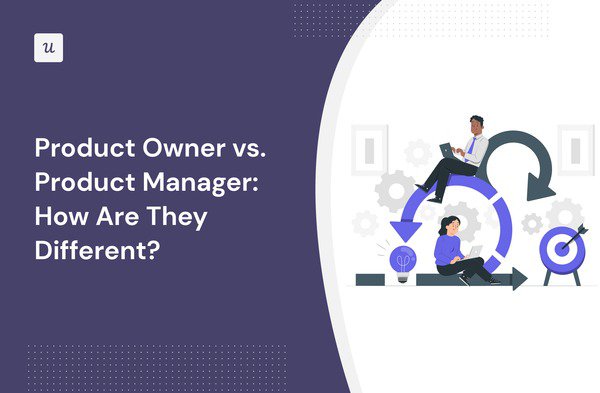Product Owner vs. Product Manager: How Are They Different?

What’s the difference between the product owner and the product manager? Where do their responsibilities overlap? How do you harmonize the collaboration between the two roles in your SaaS?
These are the key questions that this guide explores.
We also look at how Userpilot can help both product owners and product managers in their daily work.
Let’s dive in!
TL;DR
- The product manager is a multifaceted role responsible for the whole product lifecycle, from concept to launch, and beyond.
- The product owner is a role in Agile software development. It acts as the voice of the customer on the development team.
- While in smaller organizations product managers also act as product owners, the two roles differ in responsibilities, scope, and decision-making authority. They also require different skills.
- Product managers are responsible for high-level planning. They define the product vision, conduct research, and use the insights to develop a product roadmap. Product owner responsibilities include translating the roadmap into user stories, prioritizing them, and overseeing their implementation.
- The product manager focuses on shaping the overall direction of the product and its impact on the business. The scope of the product owner role is narrower: they manage the product development process.
- Key product manager skills include business acumen and strategic thinking, market and customer research, data analysis, roadmapping, and leadership. Product owners, on the other hand, need good knowledge of Agile frameworks, prioritization and backlog management skills, and relevant technical expertise.
- To measure success, product owners track velocity and sprint/release burndowns. Product managers are interested in product performance metrics like adoption, conversion rates, revenue, or customer satisfaction.
- Product owners act as a bridge between the dev team and the key stakeholders, while product managers have to collaborate with multiple teams and stakeholders across the organization.
- By distinguishing between the two roles, organizations can better allocate resources and support the development of their product teams. It also enables them to clearly define responsibilities to avoid conflicts and work duplication.
- To facilitate collaboration between PMs and POs, involve the latter in product vision, strategy, and roadmap development.
- Data democratization enables both roles to access relevant data and make autonomous decisions which increases velocity and alignment between different product functions.
- Regular progress meetings, like Sprint demos, help keep all stakeholders on the same page.
- If you want to see how Userpilot can help both PMs and POs in your SaaS, book the demo!
What is the product manager role?
The product manager role is a multifaceted position that plays a crucial role in product success.
In essence, the PM is responsible for defining the vision and strategy of a product, aligning them with customer needs and business goals, and translating them into a product roadmap.

What is the product owner role?
The product owner role comes from Scrum and is widely used by other Agile methodologies.
In short, the product owner’s job is to act as the voice of the customer on the Scrum team.
This means communicating the customer requirements to the development team, helping break them down into epics and actionable user stories, and prioritizing other backlog items like tech debt management.
Are product owners the same as product managers?
The product owner and product manager positions are not the same.
Overall, the role of a product manager is broader and encompasses high-level responsibilities like defining product vision that isn’t a part of the product owner role.
The main job of the latter is executing the plans and roadmaps developed by the product manager and senior stakeholders.
However, in smaller organizations, there’s often no need for a product owner and product managers perform their roles instead.

Why is it important to differentiate between product owners and product managers?
Understanding the difference between product owners and product managers is essential for a few reasons.
For starters, knowing the difference between the two roles enables you to decide which of them your organization needs at a particular moment in time. This allows organizations to better allocate their resources.
If you decide that you need both, having clear distinctions between these roles helps in defining specific responsibilities, expectations, and accountabilities. This helps organizations avoid overlap and conflict.
What’s more, understanding these roles can help in career planning and skill development. It clarifies the skills and experiences required for each role and allows you to support the professional growth and specialization of your staff.
It doesn’t stop here.
Understanding the distinct functions of each role can lead to a more structured and efficient product development lifecycle.
While the PM focuses on the overall product strategy and market fit, the PO can concentrate on the specifics of product execution, ensuring that the development team’s work aligns with the broader product goals.
Product owner vs product manager: What’s the difference?
Melissa Perri, a product coach and consultant, points out the key difference:
“Product owner is a ROLE you play on a Scrum team. Product manager is a JOB title.”

While technically true, this doesn’t explain the difference very well.
To get to the bottom, let’s look at differences in responsibilities, required skill sets, scope of influence, authority to make decisions, and how they collaborate with other teams.
Responsibilities
When asked about the difference in responsibilities between the two roles, Margaret Zablocka, the CEO at Onoco, said:
Product manager is responsible for the ‘Why’, whereas product owners shape the ‘What’.

What does it mean in practice?
Product manager responsibilities include managing the product lifecycle at the strategic level.
They develop the product vision and strategy to ensure their alignment with business goals and customer needs.
To be able to do so, they conduct customer research and competitive analysis and are actively involved in continuous product discovery.
It’s also their responsibility to manage the product roadmap.
Product owners, on the other hand, are responsible for product development at the tactical level.
They break down the product roadmap into actionable tasks and prioritize them in the product backlog based on feedback from the product manager and external stakeholders.
They also make sure that the development team understands the backlog items and acceptance criteria.
Scope of influence
Scope of influence is another area where the roles of the product manager and product owner differ.
The PM role has a broader scope – they shape the overall direction of the product in the market and focus on its impact on the business.
While product managers are responsible for the entire product lifecycle, from ideation to launch, and beyond, the product owner has a much more focused scope. They concentrate on the day-to-day management of the product development process.
Skills
Deep Nishar, former VP of Product at LinkedIn once said:
‘A great product manager has the brain of an engineer, the heart of a designer and the speech of a diplomat’

The quote gives you an idea of how diverse the skill set of a product manager is.
Some of the key skills include:
- Strategic thinking and business acumen
- Market and customer research
- Customer data analysis
- Technical skills (programming, design)
- Roadmapping and prioritization
- Communication
- Critical thinking and problem-solving
- Leadership
- Emotional intelligence and empathy
Product owners, just like PMs, need to be excellent communicators and problem solvers. They also need good leadership and conflict-resolution skills.
Overall, however, their skill sets are a bit more specialist than those of product managers.
A good product owner needs:
- Detailed understanding of Agile methodologies
- Prioritization and backlog grooming skills
- Solid understanding of technologies relevant to the product

Success metrics
Because of their different responsibilities and scope of influence, product owners and product managers track different metrics to measure progress.
Product owners focus on metrics like:
- Velocity – the amount of work a team can complete in a single sprint, typically expressed in story points or hours.
- Sprint burndown – the amount of work completed in the sprint.
- Release burndown – the work done across multiple sprints towards a release.
- Defects – the number of defects and bugs found in the shipped work.
In contrast, product managers are not interested in such granular metrics. For them, it’s the high-level product performance that matters. Such metrics include:
- User activation – how many users have experienced the product value first-hand.
- User and product stickiness – how good is the product at retaining customers.
- Retention and churn – how many users keep coming back to use the product or abandon it.
- Product adoption – how well embedded is the product in users’ workflows.
- Conversion rates – the percentage of users’ progression from one stage of the customer journey to another.
- NPS, PMF, CES, and CSAT scores.
- Revenue.
- Customer Acquisitions Cost (CAC), Customer Lifetime Value (CLV), and payback period.
Decision-making authority
As the product owner is a part of the development team, they have a more direct decision-making authority. They decide on what gets built and when but not necessarily how – that’s the domain of the Scrum master and the developers.
The product manager has a much broader decision-making authority. They make company-level decisions, for example, about the product vision or what product features to include in the roadmap. However, they often have little control over (or interest in) how the development work is done.
Team collaboration
When it comes to team collaboration, the product owner acts as the bridge between the development or engineering team and the product manager and senior stakeholders. One could say they communicate the product roadmap decisions to the developers and report back on their progress.

Product managers need to navigate a much more complex context.
They collaborate with cross-functional teams like marketing, sales, design, and customer success. What is more, they have to manage the external stakeholders as well as the C-suite execs inside their organizations.
How to harmonize the work between product managers and owners?
If your organization has both a product owner and a product manager, there are a few things you can do to make sure you fully realize the opportunities this offers and the two don’t get in each others’ way.
Establish a shared vision to guide the product management process
Even though it’s the PM that shapes the product vision, the product owner should be a part of the process.
By inviting the PO (as well as other key stakeholders), you gain access to their unique perspectives and help secure their buy-in and ownership. At the very least, you ensure there’s a shared understanding of the high-level product goals.
This improves the alignment and coordination of the work of the development teams and helps ship the product faster.
Develop and maintain the product roadmap
A product roadmap is a visualization of the customer outcomes that you’re planning to deliver and a timeline for it. It shows the stakeholders how the product team is planning to implement the product vision and strategy.
A product roadmap improves the coordination between the product owner and the product manager. It communicates to the product owner what product initiatives they should be working on with the development team.

Foster a culture of data democratization
Another way to improve the collaboration between the product owner and the product manager is by promoting data democratization across the organization.
Think about it:
If both the PO and the PM have access to relevant data, they can communicate more effectively, better align their work, and avoid misunderstandings. It also fosters communication and alignment at the team level.
The product owner can also use product performance and customer feedback data to make informed decisions without relying on the PM, which increases their team’s velocity and agility.

Conduct regular progress report meetings
Regular progress review meetings are essential to ensure alignment between the two roles.
The good news is that such meetings are an integral part of Agile frameworks.
For example, in Scrum, every sprint finishes with a sprint demo during which the product owners present the outputs of the sprint and gather stakeholder feedback that informs subsequent iterations.

Use tools to streamline the work of both roles
Using state-of-the-art software tools is yet another way to improve collaboration between product owners and managers.
For example, product growth platforms like Userpilot allow non-technical users to collect user behavior data and feedback to improve information sharing and enable data-driven decision-making.
Want another example?
Project management solutions, like Asana or Jira, and communication apps like Slack allow them to coordinate the efforts of all the teams involved in product management and development.
Using such tools reduces the risk of product managers and product owners getting blindsided by others’ decisions.
How can Userpilot help both the product manager and owner?
Speaking of Userpilot, let’s have a closer look at its features and how it can aid the work of product professionals.
Trigger in-app surveys for understanding customer sentiment
With Userpilot, you can easily create and trigger in-app surveys to collect user feedback. This allows you to identify areas for improvement and gauge their sentiment.
Userpilot offers a survey template library, so you don’t have to create your surveys from scratch. Once you pick the template, its customization is straightforward thanks to the visual editor. You can even use AI to translate it into another language!
Once it’s ready, you can send them to a specific user segment at a specific time or trigger them contextually when they complete an event inside your app.

Embed a feedback widget to collect feature requests
Another way to collect customer feedback is through the feedback widget.
You can add it to your resource center or product dashboard so that users can submit their feedback or feature requests whenever they feel like it.

Analyze product usage data for data-driven decision-making
Userpilot supports a range of product usage analytics features that you’d normally find in top-notch analytics platforms like Amplitude or Heap.
These include:
- User segmentation
- Code-free feature tagging
- Custom event tracking
- Heatmaps
- Funnel and Path analysis (Paths coming in Q1 2024)
- Trends analysis
- Retention analysis
- Custom dashboards

Conclusion
The roles of product owner and product manager overlap to some extent. That’s why in smaller organizations they’re often performed by the same person.
Whether you need to separate the PM and PO roles depends on how well-established your product is, the size of your business, its organizational culture, and how dogmatic you are about following the Scrum/Agile practices.
To find out more about Userpilot and how it can help product managers and product owners at your SaaS, book the demo!

